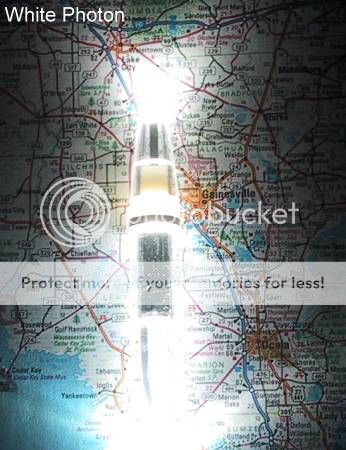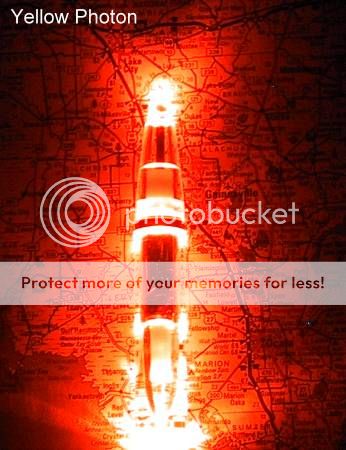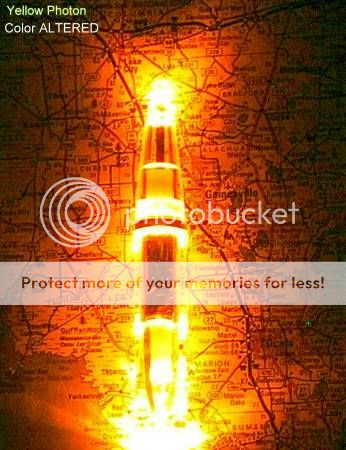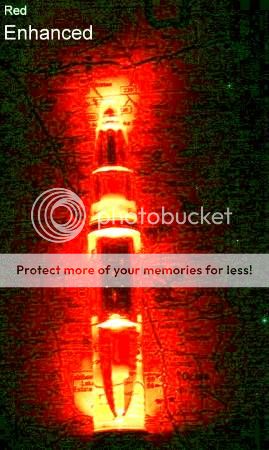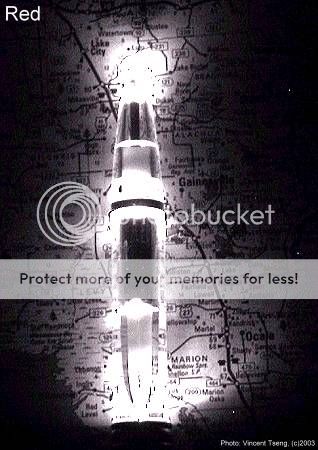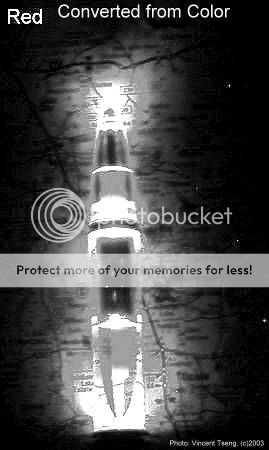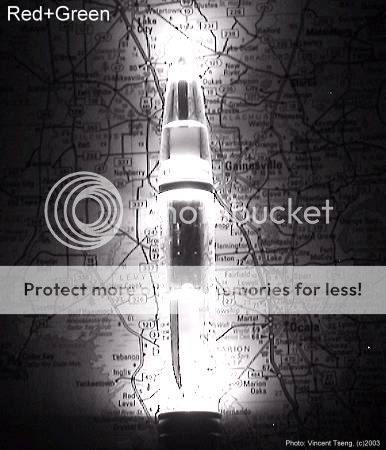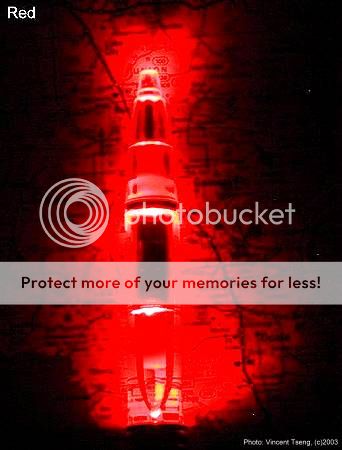After the long and illuminating thread -
Preserving Night Vision - Colors?
I was reminded about how our eyes see colors, and wondered about which colors gave us better definition for detail.
For example we know:
yellow is seen when red and green are combined
cyan is seen when blue and green are combined
magenta is seen when red and blue are combined
"white" is seen when red, green and blue are combined
I wanted to do somethng to see this for myself - which meant I should have red, green and blue LEDs/sources of light. But I didn't own these colors (other than red) since I have not had practical use for them.
Then I remembered that a good friend at a radio station gave me one of those illuminated pens that went through several colors..... yes, indeed it had red, green and blue LEDs. The LEDs were (obviously) not intensity/brightness balanced) the green looked brighter than the others with the blue the dimmest.
So here's the experiment -
I took photos (with fixed daylight white balance set) of the pen illuminated with:
red, green, blue LEDs on their own - then
red/green; blue/green; red/blue and red/green/blue combinations, and an additional photo with daylight balanced flash for comparison -
but as an sort of "bonus" I photographed the pen on a Rand McNally map page here are the results:
Daylight balanced Flash ............ & ............ "White" = red/green/blue
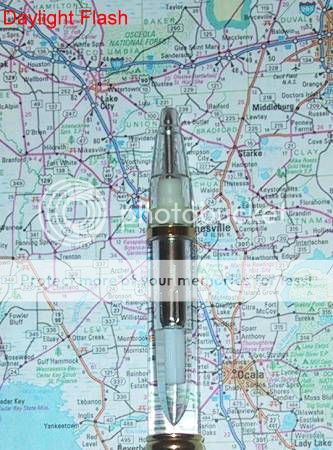
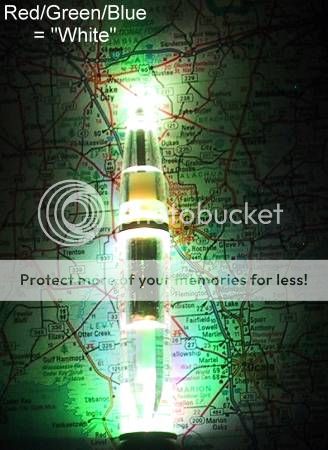
Red .................... & .......................... "Magenta" = red/blue
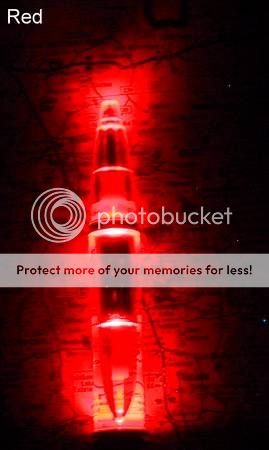
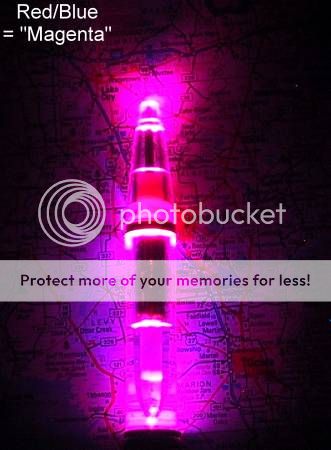
Green ........................... & .......................... "Yellow" = red/green
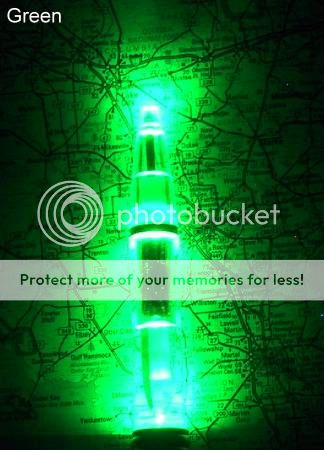
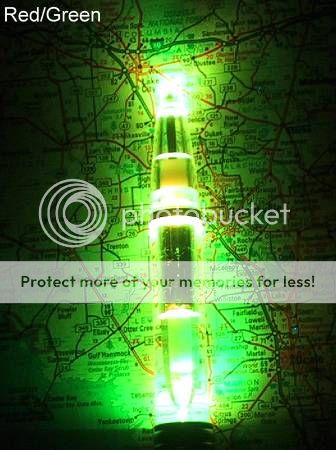
Blue ........................... & ........................... "Cyan" = blue/green
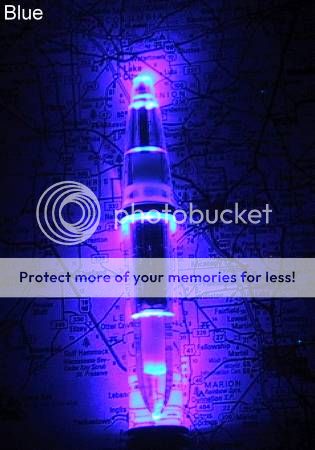
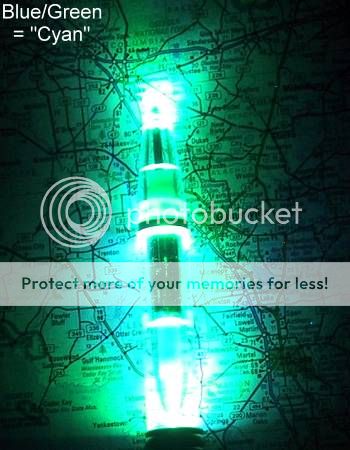
Comments/Observations
Red -
I noticed immediately that Red seem to have very poor sharpness/definition - it wasn't poor focus since the pen itself is very well focussed/sharp - neither was it camera or subject movement - again the sharp pen attests to that. I tried several shots to see if I could get a sharper image - they were all as bad - this one was the sharpest I got and I used a shade more sharpening in my photo editor - just so the image would not be as blurred. If one examines the image closely one can see near the tip of the pen very low contrast/pale image of routes and numbers are are actually very sharp.... (note: I had no problems with any of the other colors except perhaps "Magenta")
I have always said red was hard for me to see by -
but these photos caught even me by complete surprise. Perhaps my digicam has dificulty focussing red (Canon S100 Digital ELPH) but that would seem extremely unlikely that a digicam with a good repute would suffer from such gross chromatic abberrations - withOUT any reviews/tests and my own usage over 3 years revealing that....
So why there is such poor definition mystifies me.
"White" = red/green/blue combined
Here one can see that green is in fact the brightest LED in the bunch - and that this "White" does give reasonably good color rendition - and may be a bit better definition/contrast than the daylight balanced Flash photo.......
"Magenta" = red/blue combined
This is actually a nicely balanced magenta - if one looks carefully there is fairly good definition - but overall it also looks fairly blurry - but no where as bad as the red - I personally would not choose to read by this color light.
Green -
A popular color - debatable whether it is any better in seeing than magenta though when it comes down to it - the color is more pleasing but there seems that there's lots of detail that's either lost or in very low contrast - again I would not choose this color to see/read by......
"Yellow" = red/green combined -
Yes, well it is a bit more green due to the brighter green LED - despite the color being almost the same as Green on its own - I see a lot better with this color - look at the definition and contrast - it may be said to be better than the Flash and even "White" red/green/blue combination. This seems to enhance definition and contrast.
Blue
This did surprisingly well - blue light is reputed to be hard for the eye to focus (hence the blue-blocking sunglasses) but it is not quite as good as green....
"Cyan" = blue/green combine -
One can see this is better than blue or green on their own - it seems to rival the "Yellow" combination - but the overall contrast just isn't as good. I think one sees better with that "Yellow" color over this one.
Overall I wasn't that surprised - as it confirmed my suspicions - yes, I admit even Bias - but I think this is a case of more than just "wishful thinking" on my part.
The photos seem to confirm for me that I see "better" with yellow albeit with the loss of some color rendition - white often is "dazzling" for me in darker enviroments where I am trying to blend in and not affect my dark adaption severely - Red we know is the correct color to preserve true night (scotopic/rods only) vision but I just cannot see well under that color - and it is a mystery to me why even the photos appear blurry -
Please do tell me if anyone sees the red photos as nice and sharp -
perhaps I then have defective vision......
in which case all bets are off /ubbthreads/images/graemlins/grin.gif /ubbthreads/images/graemlins/grin.gif /ubbthreads/images/graemlins/icon15.gif
Comments PLEASE!
[edit: Mar/11/2004 - changed photo hosting - ImageStation is longer hotlinking]
Preserving Night Vision - Colors?
I was reminded about how our eyes see colors, and wondered about which colors gave us better definition for detail.
For example we know:
yellow is seen when red and green are combined
cyan is seen when blue and green are combined
magenta is seen when red and blue are combined
"white" is seen when red, green and blue are combined
I wanted to do somethng to see this for myself - which meant I should have red, green and blue LEDs/sources of light. But I didn't own these colors (other than red) since I have not had practical use for them.
Then I remembered that a good friend at a radio station gave me one of those illuminated pens that went through several colors..... yes, indeed it had red, green and blue LEDs. The LEDs were (obviously) not intensity/brightness balanced) the green looked brighter than the others with the blue the dimmest.
So here's the experiment -
I took photos (with fixed daylight white balance set) of the pen illuminated with:
red, green, blue LEDs on their own - then
red/green; blue/green; red/blue and red/green/blue combinations, and an additional photo with daylight balanced flash for comparison -
but as an sort of "bonus" I photographed the pen on a Rand McNally map page here are the results:
Daylight balanced Flash ............ & ............ "White" = red/green/blue


Red .................... & .......................... "Magenta" = red/blue


Green ........................... & .......................... "Yellow" = red/green


Blue ........................... & ........................... "Cyan" = blue/green


Comments/Observations
Red -
I noticed immediately that Red seem to have very poor sharpness/definition - it wasn't poor focus since the pen itself is very well focussed/sharp - neither was it camera or subject movement - again the sharp pen attests to that. I tried several shots to see if I could get a sharper image - they were all as bad - this one was the sharpest I got and I used a shade more sharpening in my photo editor - just so the image would not be as blurred. If one examines the image closely one can see near the tip of the pen very low contrast/pale image of routes and numbers are are actually very sharp.... (note: I had no problems with any of the other colors except perhaps "Magenta")
I have always said red was hard for me to see by -
but these photos caught even me by complete surprise. Perhaps my digicam has dificulty focussing red (Canon S100 Digital ELPH) but that would seem extremely unlikely that a digicam with a good repute would suffer from such gross chromatic abberrations - withOUT any reviews/tests and my own usage over 3 years revealing that....
So why there is such poor definition mystifies me.
"White" = red/green/blue combined
Here one can see that green is in fact the brightest LED in the bunch - and that this "White" does give reasonably good color rendition - and may be a bit better definition/contrast than the daylight balanced Flash photo.......
"Magenta" = red/blue combined
This is actually a nicely balanced magenta - if one looks carefully there is fairly good definition - but overall it also looks fairly blurry - but no where as bad as the red - I personally would not choose to read by this color light.
Green -
A popular color - debatable whether it is any better in seeing than magenta though when it comes down to it - the color is more pleasing but there seems that there's lots of detail that's either lost or in very low contrast - again I would not choose this color to see/read by......
"Yellow" = red/green combined -
Yes, well it is a bit more green due to the brighter green LED - despite the color being almost the same as Green on its own - I see a lot better with this color - look at the definition and contrast - it may be said to be better than the Flash and even "White" red/green/blue combination. This seems to enhance definition and contrast.
Blue
This did surprisingly well - blue light is reputed to be hard for the eye to focus (hence the blue-blocking sunglasses) but it is not quite as good as green....
"Cyan" = blue/green combine -
One can see this is better than blue or green on their own - it seems to rival the "Yellow" combination - but the overall contrast just isn't as good. I think one sees better with that "Yellow" color over this one.
Overall I wasn't that surprised - as it confirmed my suspicions - yes, I admit even Bias - but I think this is a case of more than just "wishful thinking" on my part.
The photos seem to confirm for me that I see "better" with yellow albeit with the loss of some color rendition - white often is "dazzling" for me in darker enviroments where I am trying to blend in and not affect my dark adaption severely - Red we know is the correct color to preserve true night (scotopic/rods only) vision but I just cannot see well under that color - and it is a mystery to me why even the photos appear blurry -
Please do tell me if anyone sees the red photos as nice and sharp -
perhaps I then have defective vision......
in which case all bets are off /ubbthreads/images/graemlins/grin.gif /ubbthreads/images/graemlins/grin.gif /ubbthreads/images/graemlins/icon15.gif
Comments PLEASE!
[edit: Mar/11/2004 - changed photo hosting - ImageStation is longer hotlinking]
Last edited:


